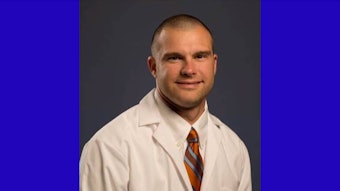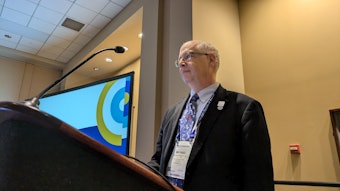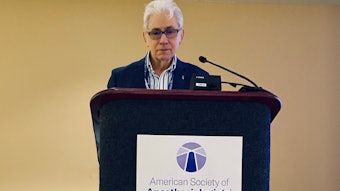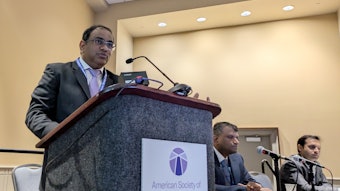ERAS and the brain
Brain health experts examine the full scope of implementing cognitive guidelines that support ERAS.

In 2017, Michelle L. Humeidan, MD, PhD, authored an article in the Huffington Post titled, “Your Body May Be Ready for That Procedure, But Is Your Brain?” Seven years later, she, along with several colleagues, reiterated the mounting, dire need to implement brain health guidelines into enhanced recovery programs.
Michael J. Scott, CHB, MB, FRCA, began the 2024 session, “Brain ERAS: Guidelines and Implementation,” by appealing to the attentive audience that while anesthesiologists know a lot about brain health, little has been done to incorporate it into standardized procedures. Dr. Scott was recently appointed as Chair of the University of Rochester Medical Center Department of Anesthesiology and Perioperative Medicine in New York.
The big WHY
Session presenter David Scott, MD, PhD, FANZCA (no relation), eased into the conversation by further amplifying the need for an Enhanced Recovery After Surgery (ERAS) pathway for brain health that spans the continuum from preoperative assessment through postdischarge follow-up.
Although most patients see positive outcomes from anesthesia and surgery, many over the age of 65 often experience some level of cognitive impairment. Delirium is the single most common complication of elective surgery in elderly patients and the fourth most significant global burden of disease, said Dr. David Scott, who is the Director of Anesthesia and Acute Pain Medicine at St. Vincent’s Hospital Melbourne, and a Professor, Department of Critical Care, Faculty of Medicine, at the University of Melbourne, Australia.
Almost half of cardiac patients have postoperative cognitive dysfunction (POCD) up to seven days into recovery. Noncardiac patients also experience POCD, and the risk differs based on type of surgery, biological factors, etc. Upon further discussion and evaluation, Dr. David Scott said the majority of these patients or their family members confessed a lack of knowledge that such a result was possible. This growing concern among patients, caregivers, providers, and communities necessitates guidelines that address brain health.
POCD affects the patient by prolonging length of stay, diminishing quality of life, and increasing risk of mortality. It also puts a burden on providers and health systems through high health costs and readmissions. Although POCD in its entirety is unavoidable, he said there are several gaps that can be filled to significantly decrease its effects.
A colleague of his, Lis Evered, BSc, MSc, PhD, FANZCA, Associate Professor, Department of Critical Care, at the University of Melbourne, Australia, continued the pursuit by identifying these gaps within the overall surgical timeline.
“The guidelines that we need to make a difference in this area require us to go beyond the hospitalization period,” said Dr. Evered. “… There are strategies that we can put into place to help. We should be preparing the brain the same way we treat and prepare the other organs for anesthesia before surgery.”
Preoperative phase
“Patients need to be involved in the decision-making process and understand the risks of surgery to decide if it is the best option or if there are alternative options, and this should be happening sooner, before it’s too late,” Dr. Evered said.
With this in mind, the following should be part of the preoperative period, she said.
- Incorporate timely, consistent risk assessments that include measurements of cognitive function (including for postoperative comparison), instrumental activities of daily living (IADL), delirium, and frailty.
- Partner with patients and their caregivers to plan for optimization, which includes pre-surgical reviews of lifestyle, nutrition, physical activity, sleep, cognitive stimulation, and pharmacy/medication expectations.
- Communicate and collaborate with primary care physicians, specialists, pharmacists, and allied health providers, such as physical therapists and occupational therapists.
- Provide thorough, transparent education and incorporate shared decision-making.
Perioperative phase
During the surgery itself, Dr. Evered said there are some data (though not definitive) that light anesthesia could help reduce the risk of POCD. She recommends aiming for this within a patient’s personalized anesthesia management plan, provided they aren’t at risk for hypotension.
Postoperative phase
While the patient is recovering and fully within the hospital’s care, clinicians should be integrating valuable resources to help mitigate the severity and longevity of delirium. This includes early mobilization, reorientation to the environment, assistance with hearing and visual aids, sleep promotion, medication review, and overall reassurance support.
Dr. Evered also said that clinicians should be providing education and opportunities for patients to stimulate their cognitive function, as well as screening for delirium at least once per shift – including on the day of discharge. When providers initiate a drink-eat-mobilize strategy following surgery, the average length of stay decreases by up to three days and compliance increases by up to 60%.
Post-discharge phase
If there is any cognitive disruption during a patient’s stay, even the slightest, Dr. Evered said they should be referred to a provider and followed up with once they leave the hospital. The care team should monitor lifestyle changes, such as nutrition, daily activity, and cognitive function, especially if the patient does not have much or any at-home support.
Jump right in
As Medical Director, ERAS, at The Ohio State University Wexner Medical Center in Columbus, Dr. Humeidan shared her boots-on-the-ground experience of implementing enhanced recovery programs. She suggested the ERAS Society, the ERAS USA chapter, the American Society of Enhanced Recovery and Perioperative Medicine (ASER), and the ASA Perioperative Brain Health Initiative – among others – as helpful resources in getting started.
Dr. Humeidan affirmed that the best place to start in creating a new ERAS pathway, or layering onto an existing one, is to establish a good team. In addition to dedicated leadership, teams should share a vision, promote trust and open communication, and uphold accountability.
“We all know what the golden rule is: Treat others as you would want to be treated,” she said. “But I want you to remember the platinum rule: Treat others how they want to be treated.”
This can be accomplished by asking questions, listening effectively, and always following up, even if you don’t have the answer or solution. Dr. Humeidan said the process can take up to 12 months, or even more, but you should not be discouraged, as important culture change takes time. One important and meaningful motivator is data – what doctor doesn’t like facts? Data can help define the problem and validate the impact of the work.
Finally, Dr. Humeidan encouraged attendees to engage their team as a whole by leveraging technology. Her teams keep all their processes in the cloud, so people can work in the same place in real time. Other tools she employs are a training portal, newsletter, interactive dashboard, ongoing feedback collection and automated reporting, and organized, standardized documentation that is accessible and trackable by all members.











